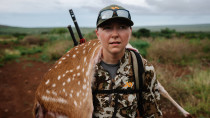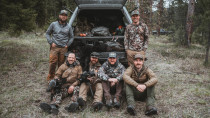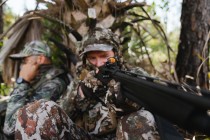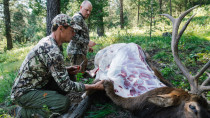Popular searches
Articles
Series
Topics
Shop
Recipes
Latest Videos
Category
Show
Season
Critter
Person
Place
Environment
Technique

20:25
Waterfowl Hunting with Flying V S02 E02 Dec 30, 2025
Close Range Montana Mallards
A quintessential, late season Montana duck hunt! For the first time, the Flying V crew hunts a project they’ve had their eyes on for the last 2 years. An old railgrade ditch clogged by years of unchecked beaver activity which was first trapped by Steve, then cleaned out to restore free flow. Follow...
Read More
Play Now

22:41
Waterfowl Hunting with Flying V S02 E01 Dec 23, 2025
Idaho Early Season Goose
Join the Flying V crew as they embark on their first hunt of the year for southern Idaho’s early goose season. Being a true freelance hunt, Brady Davis reached out to an old pal and local farmer, Kaid Panek, to help get a lay of the land and secure permission. Opening day was a huge success with...
Read More
Play Now

26:03
MeatEater Roasts S01 E11 Dec 18, 2025
Seth v Chester | Heart's Delight
In this episode of Roasts, Seth Morris takes on Chester Floyd in a heart pounding culinary showdown. Judged by Shannon Waters and Randall Williams, Seth and Chester must individually cook up a family friendly dinner with deer heart cooked over charcoal in only one hour. Presented by Kingsford
Read More
Play Now

23:35
MeatEater Roasts S01 E10 Dec 16, 2025
Nic v Jake | Christmas Bourbon Duck
In this episode, we're cooking a Christmas feast in the MeatEater Kitchen. Nic Tapia and Jake Wallace battle in a wild game cook-off while being judged and critiqued by hunters and professional chef's, Danielle Prewett and Michael Hunter. Presented by Kingsford
Read More
Play Now
13:54
Dec 11, 2025
Ribeye of The Sky
Steven Rinella hunts for a sandhill crane then puts his lab coat on for a unique culinary experiment. Comparing the tenderness and taste between his crane and a ribeye cut of beef, Steve is on a mission to find out if the sandhill crane is truly the "ribeye of the sky". Presented by Kingsford
Read More
Play Now

24:11
MeatEater Roasts S01 E09 Dec 9, 2025
Eric v Connor | Game Day Cookoff
It's College Game Day in the MeatEater kitchen. Eric Hamburg and Connor Smith get 90 minutes to test their wild game cooking skills with ground black bear burger. Judged and critiqued by Brody Henderson and Maggie Hudlow, these Montana State University students prove they won't starve to death...
Read More
Play Now

23:09
MeatEater Roasts S01 E08 Dec 4, 2025
Best Burger
In this episode of Roasts, Brody Henderson and Nate Mason compete in a wild game burger cooking competition. Dave Smith and Spencer Neuharth critique their cooking and plating techniques, then judge and select which cook whipped up the tastiest burger. Presented by Kingsford
Read More
Play Now










